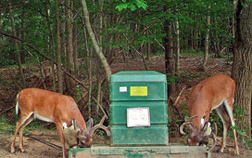Howard County Deer Do Their Part to Control Ticks
BELTSVILLE, MARYLAND, October 16, 2017—Some Maryland deer might soon self-eradicate ticks, including those that carry lyme disease, in the next phase of a study evaluating tick control strategies in Howard County, Maryland. The project finds the Agricultural Research Service (ARS), Howard County Department of Recreation & Parks and University of Maryland working together to eliminate this pest.
Beginning during the third week of October, the partners will place 4-Poster feeders/self-treatment devices in four Howard County parks with dense deer populations. Those locations are Cedar Lane Park, Rockburn Branch Park, Blandair Park, and David Force Natural Resource Area.
ARS developed and patented the 4-Poster device to apply insecticide to wildlife. The device features a central bait dispenser surrounded by paint rollers coated with “Tickicide.” Deer that feed brush against the rollers applying Tickicide to their ears and neck.
Earlier efforts to track deer in each park via GPS collars led to the placement of the 4-Posters. Other factors like ease of access, habitat, and topography also informed device placement.
One goal for ARS Area-wide Integrated Tick Management Project coordinator Andrew Li, an entomologist with the ARS Invasive Insect Biocontrol & Behavior Laboratory in Beltsville, Maryland, is to determine whether the 4-Posters influence deer routes through the parks.
“We know from past studies that the 4-Posters have effectively reduced the number of deer ticks. However, prior studies did not achieve consistent levels of tick control,” Li said. “We want to use the 4-Posters to develop an integrated tick control strategy that consistently suppresses deer tick populations in environments that will reduce people’s risk of Lyme disease.”
“We have collected base-line data about tick abundance in these parks for almost a year. It will be interesting to see if the feeders with the Tickicide impact these numbers,” said ARS wildlife technician Laura Beimfohr, who is managing the field work for the project.
This experiment is part of a larger five-year ARS Area-wide Integrated Tick Management Project. The project looks to develop methods to reduce black-legged (deer) ticks.
For more information contact Kim Kaplan, ARS Office of Communications.
The Agricultural Research Service is the U.S. Department of Agriculture's chief scientific in-house research agency. Daily, ARS focuses on solutions to agricultural problems affecting America. Each dollar invested in agricultural research results in $20 of economic impact.

